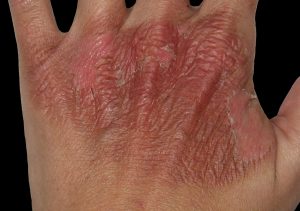
Scar massage is used in burn units globally to improve functional and cosmetic outcomes of hypertrophic scarring following a burn, however, the evidence to support this therapy is unknown. The objective of this study was to review the literature and assess the efficacy of scar massage in hypertrophic burn scars.
MEDLINE, PubMed, Embase, CINAHL and the Cochrane Library were searched using the key words “burn”, “burn injury”, “thermal injury” and “scar”, “hypertrophic scar” and “massage”, “manipulation”, “soft tissue mobilisation”, “soft tissue manipulation”. The articles were scored by the assessors using the Physiotherapy Evidence Database (PEDro) scale and outcome measures on range of motion (ROM), cosmesis (vascularity, pliability, height), pain scores, pruritus, and psychological measures of depression and anxiety were extracted.
Eight publications were included in the review with 258 human participants and 15 animal subjects who received scar massage following a thermal injury resulting in hypertrophic scarring. Outcome measures that demonstrated that scar massage was effective included scar thickness as measured with ultrasonography (p=0.001; g=-0.512); depression (Centre for Epidemiologic Studies – Depression [CES-D]) (p=0.031; g=-0.555); pain as measured with Visual Analogue Scale (VAS) (p=0.000; g=-1.133) and scar characteristics including vascularity (p=0.000; g=-1.837), pliability (p=0.000; g=-1.270) and scar height (p=0.000; g=-2.054). Outcome measures that trended towards significance included a decrease in pruritus (p=0.095; g=-1.157).
It appears that there is preliminary evidence to suggest that scar massage may be effective to decrease scar height, vascularity, pliability, pain, pruritus and depression in hypertrophic burns scaring. This review reflects the poor quality of evidence and lack of consistent and valid scar assessment tools. Controlled, clinical trials are needed to develop evidence-based guidelines for scar massage in hypertrophic burns scarring.
No comments:
Post a Comment